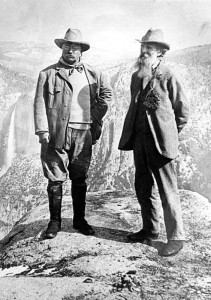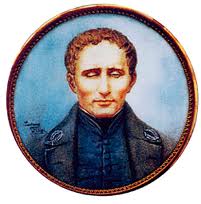Learning Step by Step
In her second installment of a two-part article for MiddleWeb, New Jersey teacher Mary Tarashuk tells us more about how she’s using The Walking Classroom program in her 4th grade classroom. Included in this article: How Mary integrates the TWC content with her existing curriculum and lesson plans. Find out more about how she launched TWC in her first article.
by Mary C. Tarashuk
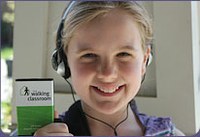 We are all donning our own set of headphones, synchronizing our watches and WalkKits, and heading out of the classroom to enjoy a 15-20 minute ‘podcast’ — the term we use for our (pre-recorded) audio encounters with Franklin Delano Roosevelt, Sojourner Truth and Elizabeth Cady Stanton, or the stories we hear about events like exploring west of the Mississippi with Lewis & Clark and Sacagawea. Each time we get back from our walks, the kids are ruddy-cheeked, a bit thirsty, and raring to learn more.
We are all donning our own set of headphones, synchronizing our watches and WalkKits, and heading out of the classroom to enjoy a 15-20 minute ‘podcast’ — the term we use for our (pre-recorded) audio encounters with Franklin Delano Roosevelt, Sojourner Truth and Elizabeth Cady Stanton, or the stories we hear about events like exploring west of the Mississippi with Lewis & Clark and Sacagawea. Each time we get back from our walks, the kids are ruddy-cheeked, a bit thirsty, and raring to learn more.
Before the recent U.S. Presidential Election, I began incorporating our Social Studies unit on elections with The Walking Classroom podcasts that enhance the subject beautifully. We listened and walked through The Great Depression, analyzed Franklin Delano Roosevelt’s famous inaugural speech about the fear in our country, and compared our current economic and unemployment challenges to those of the country during the 1930s.
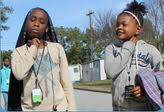 The Social Studies standards ask us to ask kids the big questions. They ask us to connect our students to history and to help them look for its impact on our world today. My students’ understanding seems to have much more depth than it did when I covered this topic four years ago using a more traditional approach to teaching.
The Social Studies standards ask us to ask kids the big questions. They ask us to connect our students to history and to help them look for its impact on our world today. My students’ understanding seems to have much more depth than it did when I covered this topic four years ago using a more traditional approach to teaching.
This year, my kids are displaying more of their analytical abilities as economists and political scientists, as well as historians. They are discussing Black Tuesday and the role of government. They are discussing the meaning of responsibility and how we handle crises as a nation. (They are also telling me their parents’ specific political views by repeating comments heard at home, but that is a topic for another article!)
Election interrupted
This year my class spearheaded the plans for our schoolwide mock election. The kids worked dutifully as they sorted multi-colored ballots to distribute to each class in the school. The individual classrooms were assigned various states and their corresponding electoral votes. My kids chatted about the state of the nation as they labeled each ballot with the state name and clipped grouped ballots together to deliver around the school. The fourth grade registered every child in the school in preparation for the big day.
And then Hurricane (aka, Superstorm) Sandy came to visit.
We were out of school and out of power for nine days. The day we returned to school, I met them outside on the blacktop. They were lined up near a massive generator that had been put in place as a result of the intense storm. They were so excited to tell their tales of the insanity.
I had to laugh when I heard Sam asks, “Are we walking today?”
This was followed by several “Yeah”s” and expectant eyes.
“No, gang,” I explained. “We’ll get back in the swing next week, once we are settled back into school.”
They looked a little disappointed until I pointed out that it was currently Friday. Then they smiled.
The disappointed looks returned when they found out that we wouldn’t be having the school election. In fact, many of my students were more upset about that than they were about having missed Halloween. (That actually thrilled me.)
Missing the election doesn’t mean our discussions about its impact won’t continue as we explore our vast country. Our curriculum dictates a study of the regions of the United States. We can certainly learn about its history on our walks. I’m excited to try podcasts about “hot topics” from the past, like Reconstruction after the Civil War or the establishment of National Parks and John Muir’s role in it. He camped with Teddy Roosevelt. The kids will love that story.
As we experience The Walking Classroom, my students’ ability to integrate big ideas across the curriculum continues to encourage me. As we delve into new topics each week, they are eager to explore new material, to meet people from the past who have made an impact on our lives, and to make personal connections in an attempt to see the larger picture of our world today.
Walking and talking about books
My district adopted a balanced literacy approach to Language Arts this year. Our first theme focused on what it means to be “a reader,” asking us to think about the benefits of reading and to analyze how reading makes an impact on our lives.
I recently used two of our Walking Classroom recordings — the biographical podcasts on Louis Braille and Johannes Gutenberg — to let the kids take a closer look at how science and innovation have changed the reading lives of so many. I wanted them to think deeply about how the waves created by these inventive men from so long ago continue to ripple through our modern culture.
They were amazed at the facts that they learned, at how books were once actually written by hand and considered rare, about the effort to give blind people the same reading opportunities as those with the gift of sight.
My students couldn’t stop talking about a world with no books, how thankful they were for these two literacy pioneers, and how their contributions changed the world. They happily wrote well-developed essays on this very topic. Even my resistant writers had something to say, and I heard no grumbling about the task laid before them. That, in itself, seemed almost miraculous to me (especially since one of them had to overcome the long habit of crumpling his paper into a ball, digging his heels in, and refusing to write).
We are studying the ocean floor in Science. There is a podcast about that. United States History is built into a large number of podcasts, covering topics that range from western expansion to civil rights. Poetry and figurative language lessons and Greek and Latin root words are the focus of many podcasts. There is even a lesson about Abbott and Costello’s famous “Who’s on First” shtick!
We are in the third month of the school year, and the novelty of walking while we learn hasn’t worn off. So long as the materials engage them, I don’t think it will.
Healthy, lifelong learners
It’s been reported that our current generation of American kids is the first generation expected to have a shorter life expectancy than their parents. That is a frightening forecast.
Our world and its technology have made it so easy to be sedentary, to sit in front of the television, a video game, or a computer. We have fast food and fast-paced lives, and sometimes we sacrifice healthy for convenient. In my experience, children learn what they live.
Why not use technology in a way that will foster a healthier lifestyle for our kids, to make them life-long learners and adults who appreciate that our bodies, like our minds, need exercise? I believe they will come to see that proper nutrition isn’t a punishment, but an opportunity to live well and take good care of ourselves.
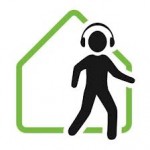 Laura Fenn, the creator of The Walking Classroom, set out to incorporate physical fitness and content area topics into the curriculum simultaneously. She created this non-profit organization to help teachers and kids foster a love of learning, one step at a time. And I know from our conversations that she works hard to find the funds to help underwrite the program in schools and classrooms that otherwise couldn’t afford it.
Laura Fenn, the creator of The Walking Classroom, set out to incorporate physical fitness and content area topics into the curriculum simultaneously. She created this non-profit organization to help teachers and kids foster a love of learning, one step at a time. And I know from our conversations that she works hard to find the funds to help underwrite the program in schools and classrooms that otherwise couldn’t afford it.
As an educator who at times feels a bit overwhelmed with the curriculum changes and additions that seem to expand the school day — without actually affording teachers with the precious time we need to fit it all in — I can say that this program has enabled me to use a cross-curricular approach to teaching without adding to my teaching stress. It is like killing ‘three or four birds with one stone,’ an exaggeration on a metaphor that I have always found to be a bit troubling, but fitting in this circumstance.
I am combining skills and goals that meet the standards of multiple content areas. This program is directly aligned with The Common Core Standards on Language and Literacy that are being adopted across our country. And we get to go outside for it!
Already, The Walking Classroom has won several awards and been recognized nationally by The Active Schools Acceleration Project, an initiative of ChildObesity 180, for innovation in the use of incorporating technology and physical fitness.
Laura Fenn began this work from her own classroom and turned her little idea into a big reality — a reality that my current students are enjoying immensely. And quite frankly, so am I.
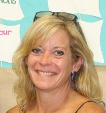 Mary C. Tarashuk has been teaching fourth grade in Westfield, New Jersey for 14 years. Her enjoyment of hiking and nature inspired her to incorporate the outdoors into her teaching. She’s been an integral part of bringing cultural arts assemblies into her school, presented new instructional strategies at district-wide parent information nights, collaborated with colleagues to revise her district’s mathematics curriculum, and is currently writing her first novel, Behind the Doors of the Teachers Room.
Mary C. Tarashuk has been teaching fourth grade in Westfield, New Jersey for 14 years. Her enjoyment of hiking and nature inspired her to incorporate the outdoors into her teaching. She’s been an integral part of bringing cultural arts assemblies into her school, presented new instructional strategies at district-wide parent information nights, collaborated with colleagues to revise her district’s mathematics curriculum, and is currently writing her first novel, Behind the Doors of the Teachers Room.

